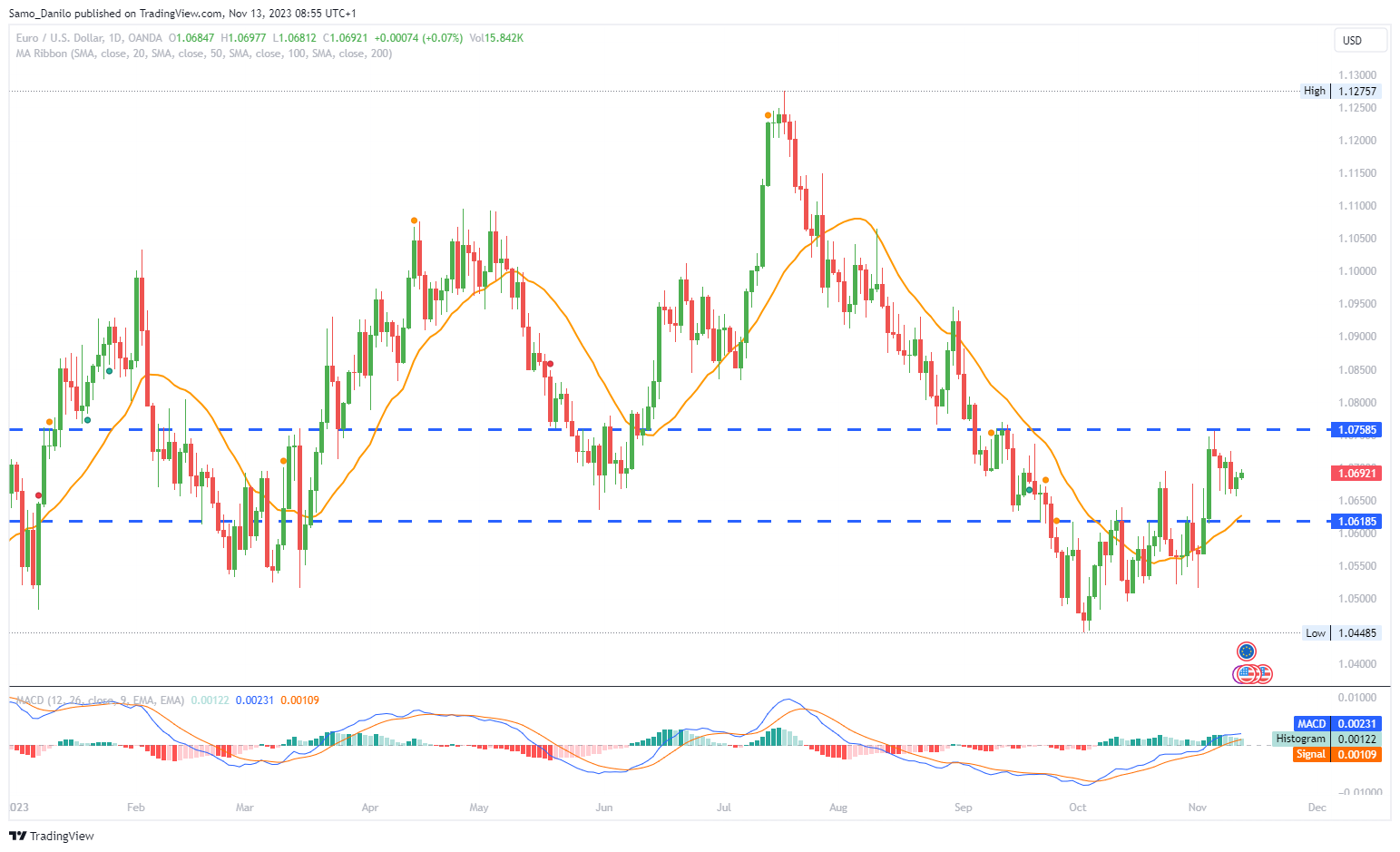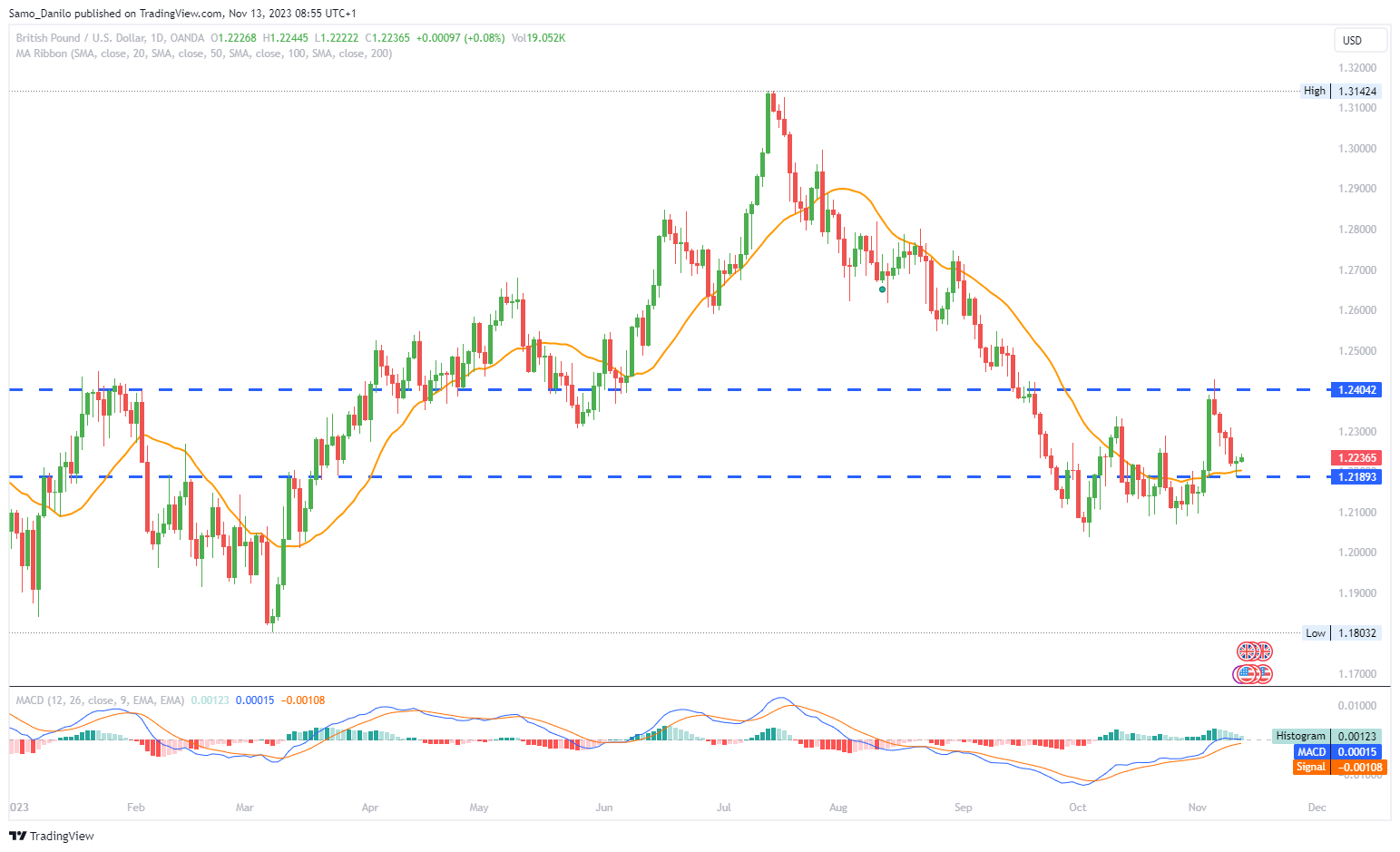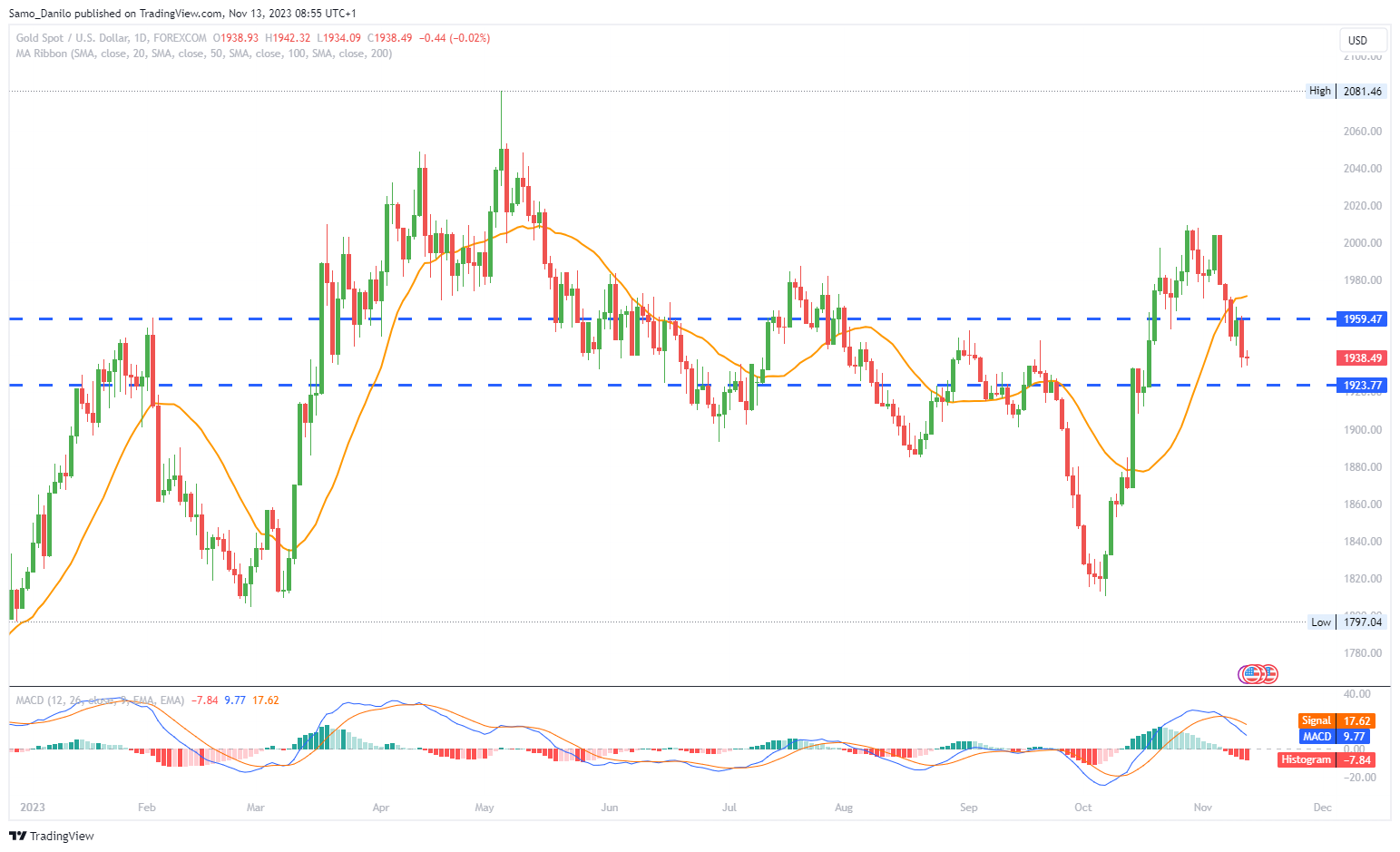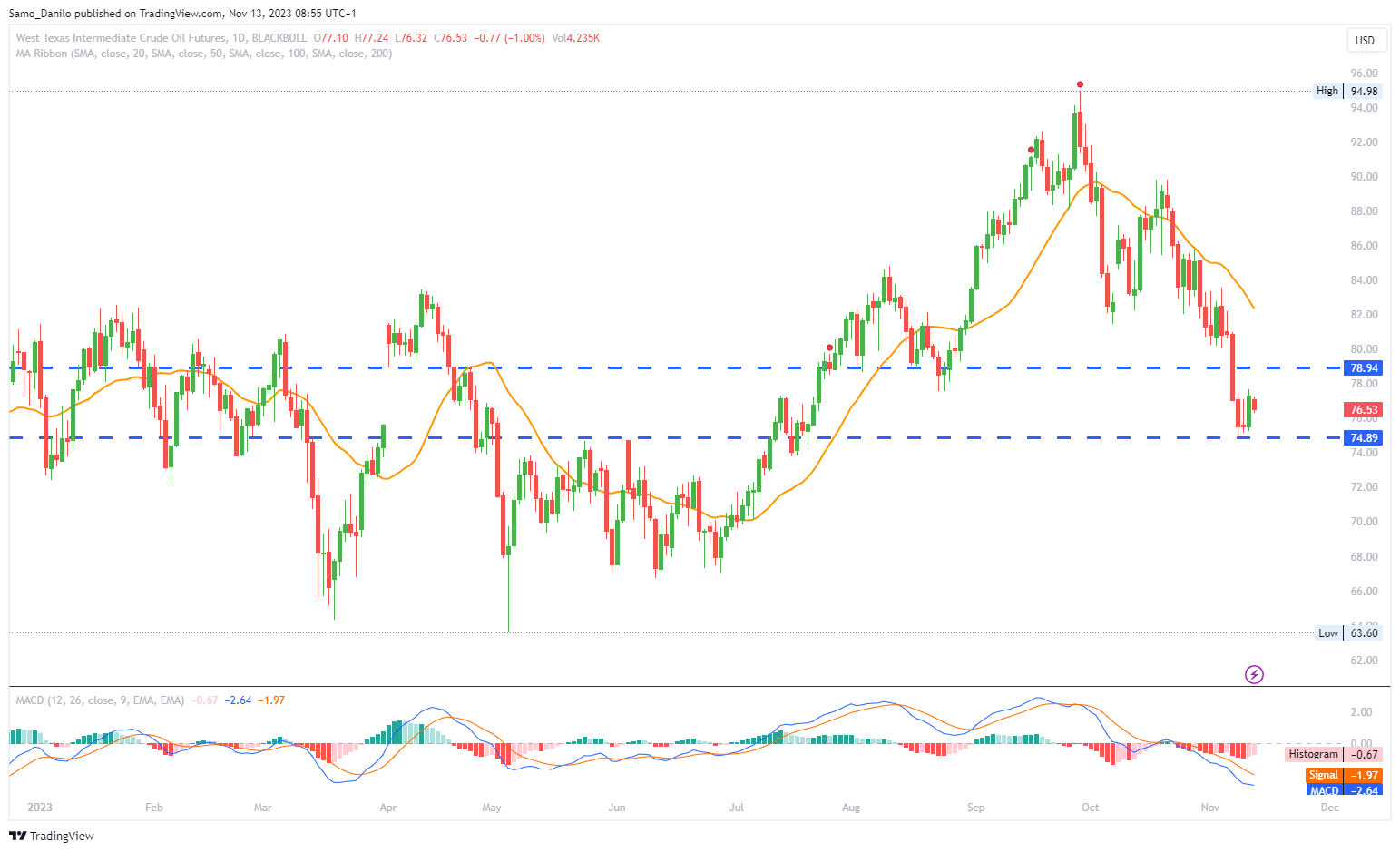EURUSD
- The EUR/USD pair is currently moving within a narrow trading range below the 1.0700 level during the Asian session on Monday. This suggests a period of consolidation or indecision among traders as they await key economic data.
- Traders are exercising caution and waiting on the sidelines ahead of the release of Eurozone Gross Domestic Product (GDP) figures for the third quarter (Q3). The forecast indicates a contraction of 0.1% in quarterly growth, while the annual figure is expected to show a modest growth of 0.1%. The outcome of this data release can significantly influence the direction of the EUR/USD pair.
- Federal Reserve Chairman Jerome Powell's recent comments at a monetary policy panel organized by the International Monetary Fund underscore the Fed's data- dependent approach. Powell mentioned that the Fed is not yet confident that they have achieved a "sufficiently restrictive" policy stance to bring inflation down to the target of 2% over time.
- Despite Powell's remarks, the CME Group FedWatch Tool indicates that markets are still pricing in a high probability (90%) of the Federal Reserve leaving the policy rate unchanged in December. This suggests that, at least according to current market expectations, a December rate hike is not anticipated.
Closing statement: In summary, the EUR/USD pair is currently in a consolidative phase, with traders awaiting Eurozone GDP data for Q3. Powell's comments on the data-dependent approach and market expectations for the Fed's December decision are key factors influencing the currency pair's dynamics. The Eurozone economic data and any shifts in Fed policy expectations can be expected to drive movements in the EUR/USD pair in the near term.
GBPUSD
- GBP/USD has seen consecutive gains, trading higher around 1.2230 during the Asian session on Monday. This upward movement could be attributed to a combination of factors, including a better-than-expected preliminary GDP from the United Kingdom and a weaker USD.
- The Office for National Statistics (ONS) reported that the UK's Gross Domestic Product (GDP) expanded at an annual rate of 0.6% in the third quarter. This positive economic growth figure could contribute to the strength of the British Pound (GBP) against the US Dollar (USD).
- Additional UK economic data includes the stagnation of Industrial Production on a monthly basis in September, a 0.1% increase in Manufacturing Production, and a 4.2% decline in Total Business Investment on a quarterly basis in the third quarter. These indicators provide a broader picture of economic activity and investment trends in the UK.
- GBP/USD traders are anticipating a significant week ahead with a focus on the UK economic docket, which is set to unveil employment and inflation data on Tuesday. These releases can have a notable impact on currency markets, influencing the direction of GBP/USD.
- On the US front, attention will be on the US Consumer Price Index (CPI) on the same day. CPI is a key inflation indicator, and its release can influence market expectations regarding future monetary policy decisions by the Federal Reserve.
| SMA (20) | Slightly Rising |
|
| RSI (14) | Neutral | |
| MACD (12, 26, 9) | Neutral |
Closing statement: GBP/USD has experienced gains, possibly fueled by positive UK GDP figures and a weaker US Dollar. The upcoming UK economic data releases, particularly on employment and inflation, along with the US CPI data, are expected to be pivotal events influencing the currency pair's movement in the coming days.
GOLD
- Federal Reserve (Fed) Bank of San Francisco President Mary Daly mentioned on Friday that she is not ready to determine whether the central bank is finished with its interest rate cycle aimed at bringing inflation back to 2%.
- Fed Chair Jerome Powell emphasized that if tightening policy further becomes appropriate, the Fed will not hesitate to do so. These statements indicate that the Fed remains vigilant about its monetary policy stance.
- Traders are closely monitoring key data releases, particularly the US Consumer Price Index (CPI) scheduled for the upcoming week. Economic indicators play a crucial role in shaping market expectations regarding monetary policy.
- There are concerns about economic growth in China, which may impact the price of gold. China is both the world's largest gold producer and consumer. Any indications of economic slowdown in China could potentially lead to lower demand for gold.
- The focus of traders will be on the US Consumer Price Index (CPI) scheduled for Tuesday. The monthly CPI reading is expected to ease to 0.1% in October, while the core CPI is estimated to remain unchanged at 0.3%. These figures are crucial as they provide insights into inflation trends, influencing market expectations and, consequently, the direction of gold prices.
| SMA (20) | Rising |
|
|
| RSI (14) | Falling |
|
|
| MACD (12, 26, 9) | Falling |
|
|
Closing statement: Gold is influenced by statements from Fed officials, market sentiment regarding key data releases, concerns about economic growth in China, and the upcoming US Consumer Price Index (CPI) data. Traders are likely to closely watch the CPI figures for cues on inflation trends and potential impacts on gold prices.
CRUDE OIL
- West Texas Intermediate (WTI) Crude oil prices are retracing the gains made on Friday and are currently trading near $76.40 during the Asian trading hours on Monday. This retracement suggests a shift in market dynamics.
- The overarching concern influencing market sentiment is the worry about diminishing demand for Crude oil in both the United States (US) and China. Economic indicators, such as China's declining inflation for October, are seen as signals of reduced global growth prospects. This, in turn, has a direct impact on the demand for crude oil.
- China, being a major oil importer, plays a significant role in the global demand for crude oil. The mention of China's declining inflation raises concerns about the overall economic health of the country, influencing the demand for commodities like crude oil.
- Despite concerns about demand, oil prices experienced a nearly 2.0% gain on Friday. This was attributed to Iraq's endorsement of oil cuts by OPEC+, indicating efforts to stabilize oil prices through production adjustments.
- There are contrasting signals regarding the global oil supply. While there are concerns about potential supply disruptions stemming from the Middle East conflict, industry data revealing a significant build in US crude inventories counters the positive impact of Saudi Arabia and Russia's commitment to cut 1.2 million barrels in 2024.
| SMA (20) | Falling |
|
|
| RSI (14) | Falling |
|
|
| MACD (12, 26, 9) | Falling |
|
|
Closing statement: In summary, the retracement in WTI Crude oil prices is driven by concerns over diminishing demand in major economies, particularly the US and China. Despite positive signals from OPEC+ efforts, the contrasting signals on global oil supply, especially the notable build in US crude inventories, are contributing to the overall market sentiment. Traders are closely monitoring the delicate balance between demand and supply dynamics in the oil market.
DAX
- On Friday, ECB President Christine Lagarde issued a warning about a potential pickup in inflationary pressure at the turn of the year. Despite acknowledging this, Lagarde suggested that the ECB might not necessarily pursue another rate hike immediately emphasizing a cautious approach to monetary policy. The nuanced stance is expressed through her statement, "We are at a level where we believe that, if kept long enough, will take us to the 2% medium-term target."
- The DAX experienced negative movement on Friday, influenced by a hawkish speech from Federal Reserve Chair Jerome Powell. Powell's speech, delivered overnight on Thursday, carried a hawkish tone, impacting global markets and affecting the DAX.
- On Monday, Porsche is set to release its earnings results, and these results are expected to have an impact on the broader auto sector. Beyond the immediate earnings, investors will likely focus on the outlook provided by Porsche, especially in the context of a weak demand environment.
- There are no specific economic indicators for Germany, or the Eurozone mentioned for the immediate period. However, investors are advised to keep an eye on ECB commentary, particularly given the recent statements from President Lagarde.
- Short-term trends for the DAX will likely be influenced by key economic events, including US inflation figures scheduled for Tuesday, and Eurozone GDP (also on Tuesday) and inflation numbers (on Friday). These events will be crucial in shaping market sentiment and influencing the trajectory of the DAX.
| SMA (20) | Falling |
|
|
| RSI (14) | Slightly Rising |
| |
| MACD (12, 26, 9) | Rising |
|
|
Closing statement:In summary, the DAX is navigating a complex landscape influenced by global central bank communications, particularly from the ECB and the Federal Reserve. The market is reacting to nuanced statements on inflation and rate hike expectations. Additionally, corporate earnings, such as those from Porsche, play a significant role in shaping the sentiment of the auto sector and, by extension, the DAX. Investors are keeping a close watch on upcoming economic indicators for further guidance.




